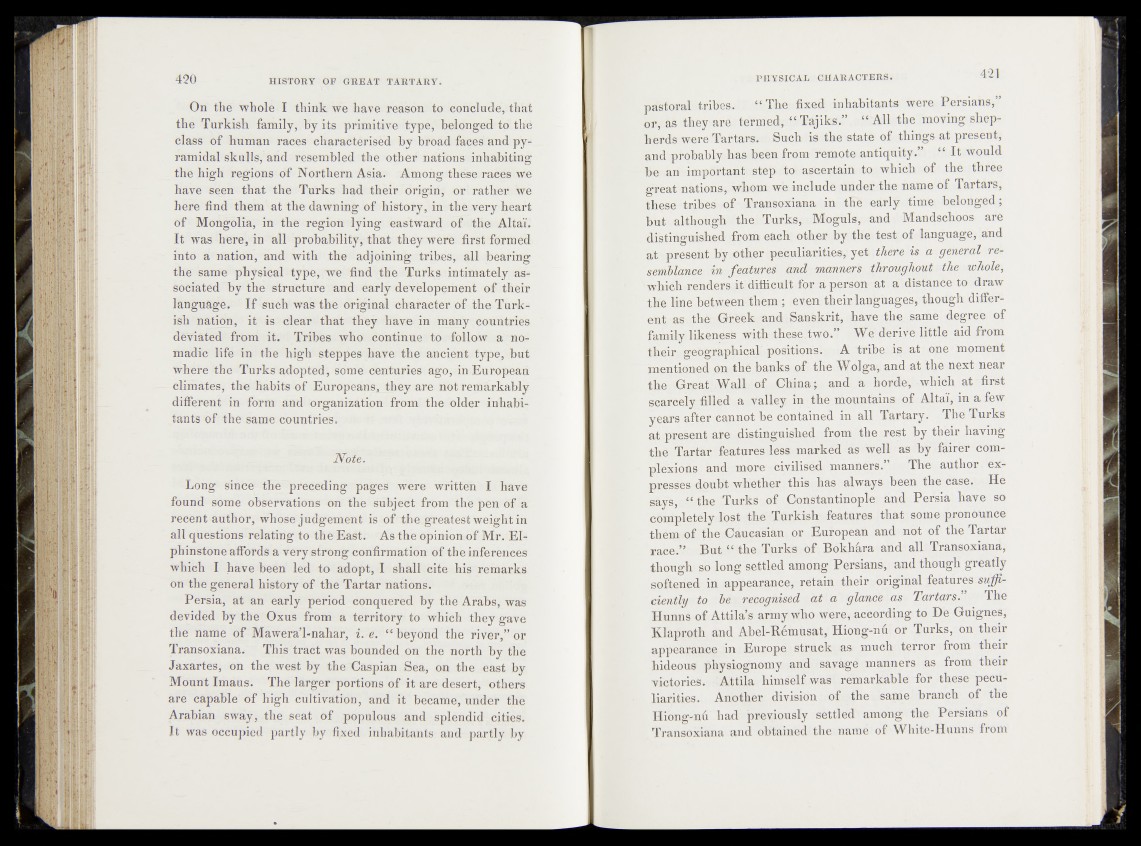
On the wholè I think we hâve reasèniitç conclude,; that
the Turkish family, by its primitive type' 'helonged td the
class of human races characterised by broad -feces and pyramidal
skulls, and resembled the other nationsrinbahitmg
thé high regions of Northern Asia. Among thliÉe^raÉÉs<we
have seen that the Turks had their 'ôrâgririi .-»à?' rather we
here find them at-the dawning of 'history, in the very heart
of Mongolia, in the region lying eastward of the Altaï.
It was here, in all probability, that they were first formed
into a nation, and with the adjoining tribes, all b^
the same physical type, we find the Turks intimately associated
by the structure. and early devèlopçment of-.their
language. If such was the original character of the Turkish
nation, it is clear that they have in mainy countries
deviated from it. Tribes who continue ^tpSl^low a
madic life in the high steppes have’the an cimfetype,shut
Whére -the Turks adopted, some centuries âgo,dn European
climates, the habits of Europeans, they are d® refeiïfeàblÿ
different in form and organization from theJolder inhabitants
of the same countries: ?
Note.
Long since the preceding pages were written I have
found some observations on the subject from thdjifcF of . a
recent author, whose judgement is of the^greatest weight in
all questions relating to the East; As the opiniouof Mr. EI-
pliinstone affords a very strong confirmation of the inferences
which I have been led to adopt, I shall cite his remarks
on the general history of the Tartar nations.
Persia, at an early period conquered by the Arabs, was
devided by the Oxus from a territory to which they gave
the name of Mawera’l-nahar, i. e. “ beyond the river,” or
Transoxiana. This tract was bounded on the north by the
Jaxartes, on the, west by the Caspian Sea, on the east by
Mount Imaus; The larger portions of it are desert, others
are capable of high cultivation, and it became, under the
Arabian sway, the seat of populous and splendid cities.
It was occupied partly by fixed inhabitants and- partly by
pastoral tmb'aróT ‘'‘Tilae.; «fixed inhabitants were Persians,
br> as thejfare,;terpejf ‘‘ . “ All the moving shepherds'Wiere
Tartars. Sulim's the static of,things at present,
and probably has .been from remote^autiquity jg| ‘- It would
be an importants step toi asce^fcatim?fc> which of the three
great nations,vwhom. wp impluderilfideiL the name of Tartars,
these -t^ibeéieef'.^EatnsQxiatia in the early time: belonged ;
but although the Turks, Moguls,, and* Mandsehoos are
distinguished from each other* .by thesMspst^o# language, and
at preseht;hy other 'peculiarities,! y<è$iihéne is a general resemblance
êmfeaiures and, Manners throughoutthe whole,
ywb*ehrendersat.difficult ffifapex^onsat a distance to draw
the hue between them ; their languages, though different
as (the -Greek and, Sanskrit, have the^.same degree of
family likèjnesl with these.two.” We1 derive little aid from
their^gehgraph ical positions; A tribpijgljs at one^tDoment
mentioned pa. thé banks of5 the Wolga,, and at the next near
Aq^Great Wall of <Qhina; and a horde, -which at'first
scarcelycfilled .a valley in the mountains pf Altai, in a few
years afternannot be contained in all Tartary. The Turks
at present are distinguished from the rest by their having
the Tartar features less.finarked as well as by fairer complexions
and more civilised manners.” . The author expresses
doubt whether thisfchas always been the case-^.-He
says, “ the Turks of Constantinople and Persia have so
completely lost the Turkish features that,some pronounce
thèm of the Caucasian or European and not of the Tartar
race.” But “ the Turks of Bokhara and all Transoxiana,
though so long Settled among Persians, and though greatly
softened in appearance* retain their,^original features sufficiently
to be recognised at a glance as Tartars. The
Hunns of Attila’s army who were, according to De GuigneS,
Klaproth and Abel-Rémusat, Hiongdifi? or Turks, on their
appearance in Europe^ struck as much: terror from their
hideous physiognomy and savage manners as from their
victories. -Attila himself was remarkable for these peculiarities.
Another division of the same branch of the
Hióng-niï had previously settled among the Persians of
Transoxiana and obtained the name of Wbite-Hunns from